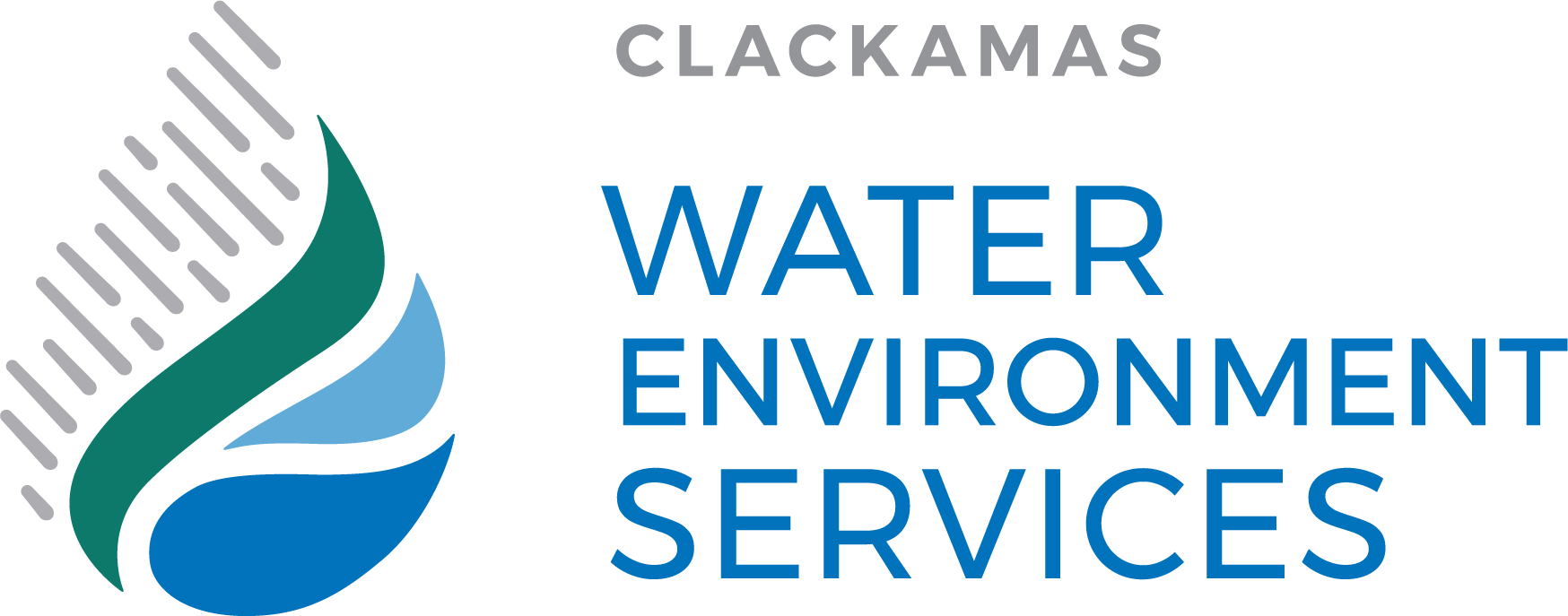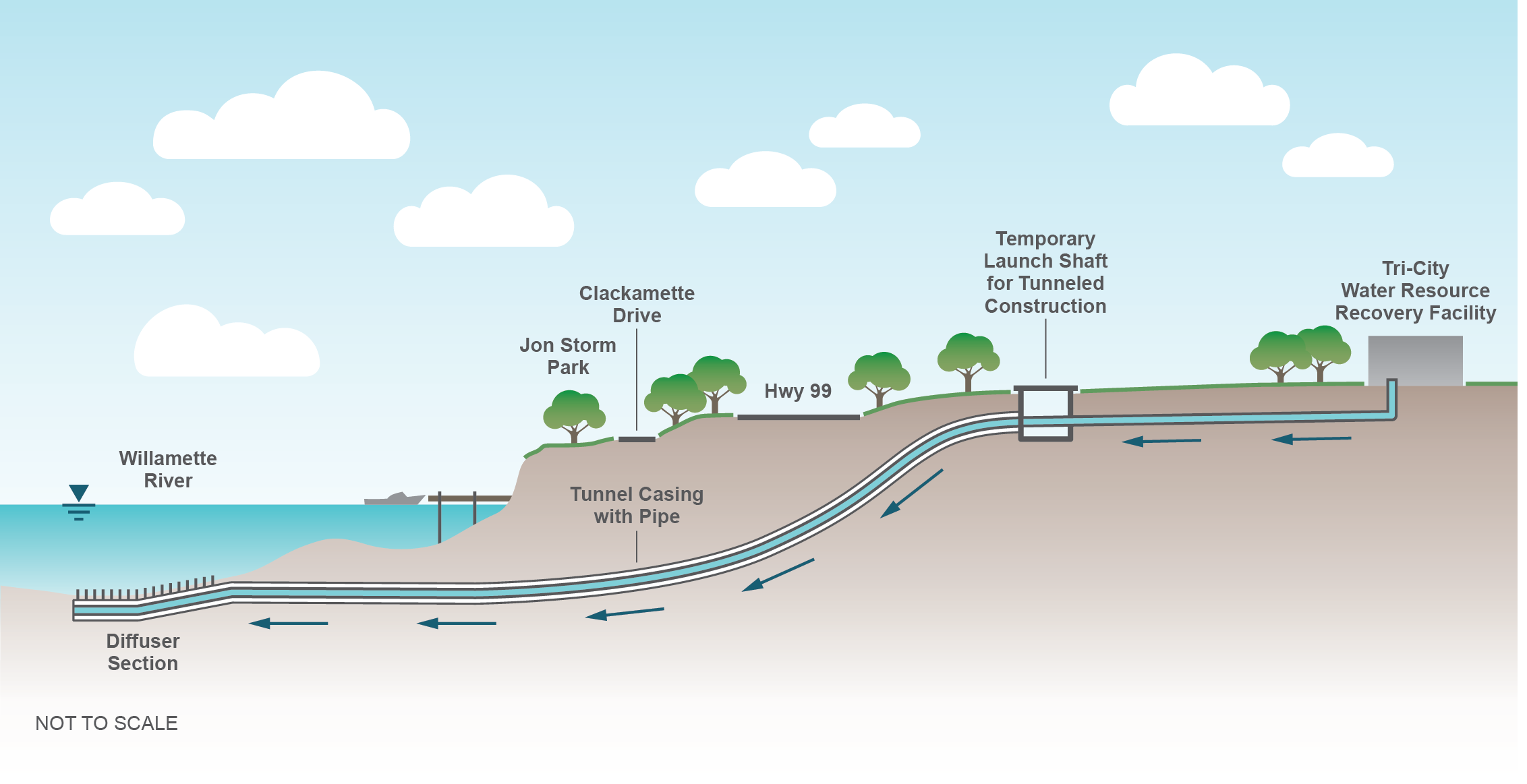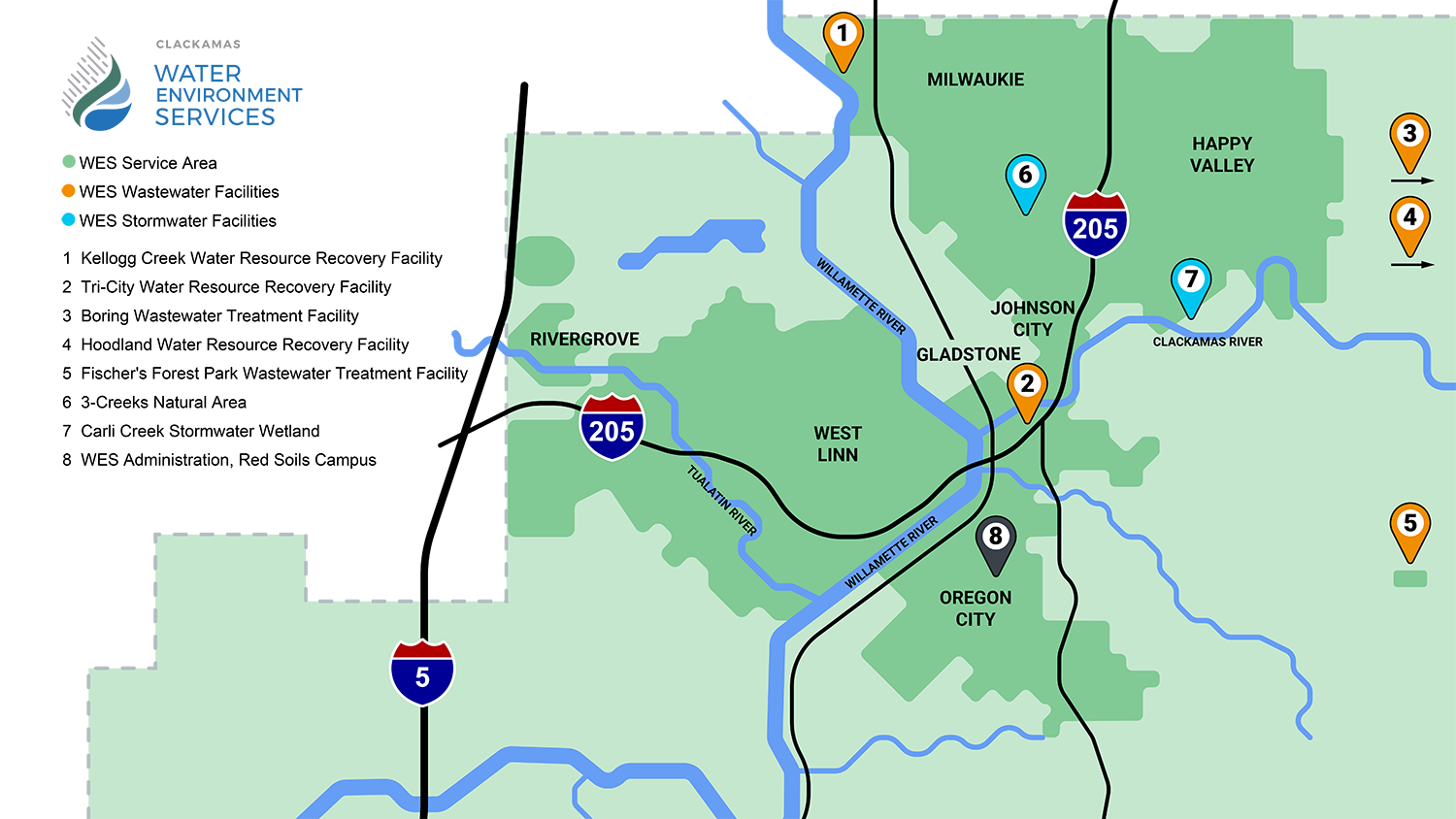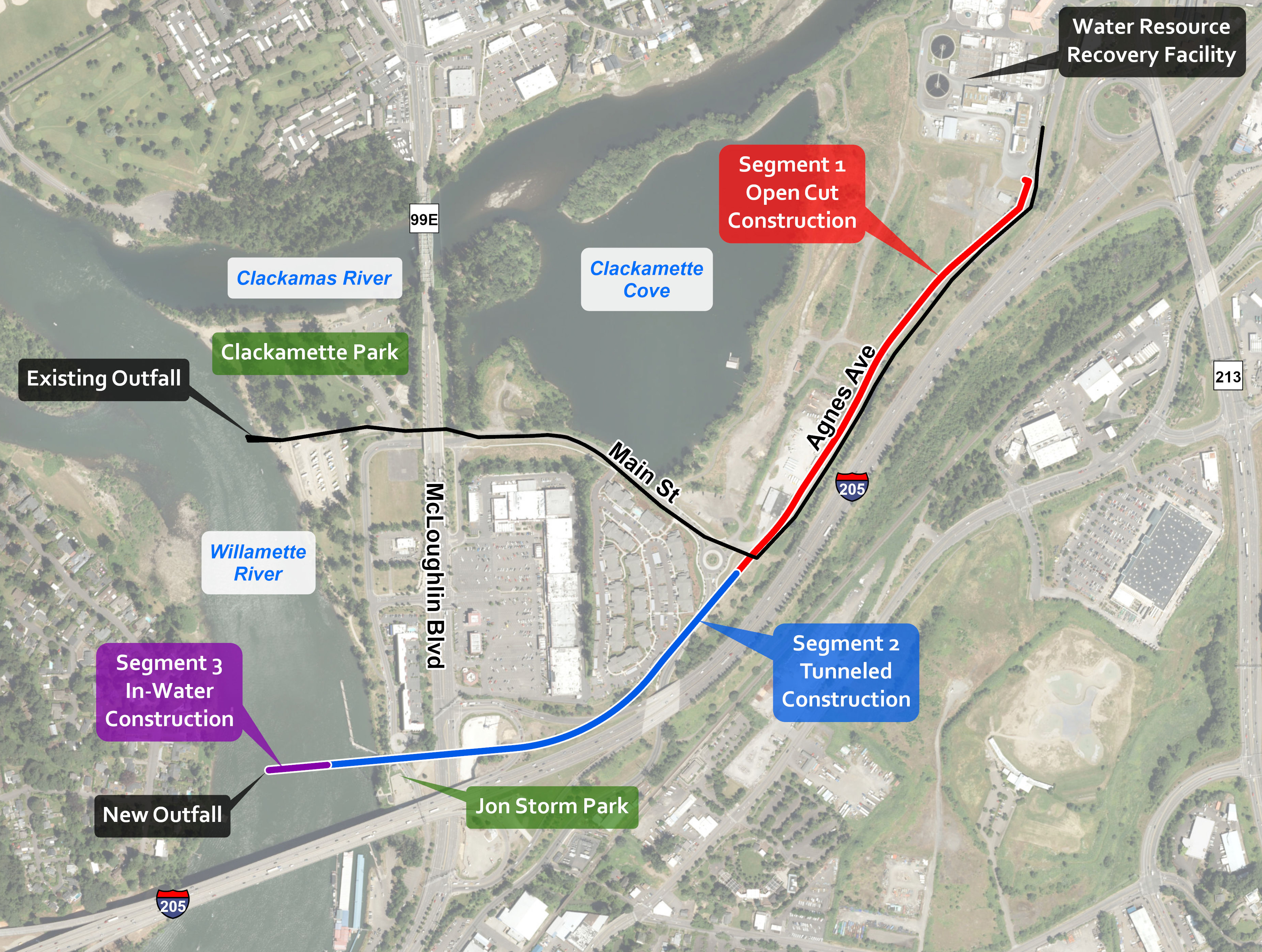What is an Outfall?
Every day, Clackamas Water Environment Services (WES) cleans more than 10 million gallons of wastewater at its Tri-City Water Resource Recovery Facility in Oregon City. The treated water, called “effluent,” is then sent back to the Willamette River. An outfall is the discharge point where the treated water flows into the river.
An outfall is designed to maximize mixing and dilution of effluent. The mixing must meet state water quality standards for boating, swimming, fishing, and aquatic resources.
Learn more about the project...
About Clackamas Water Environment Services (WES)
Clackamas Water Environment Services produces clean water and protects water quality. It’s our job to ensure that residents and visitors enjoy the benefits of safe, healthy water for generations to come. We operate and maintain five resource recovery facilities, 23 pumping stations, and more than 360 miles of pipes. Learn more about WES...
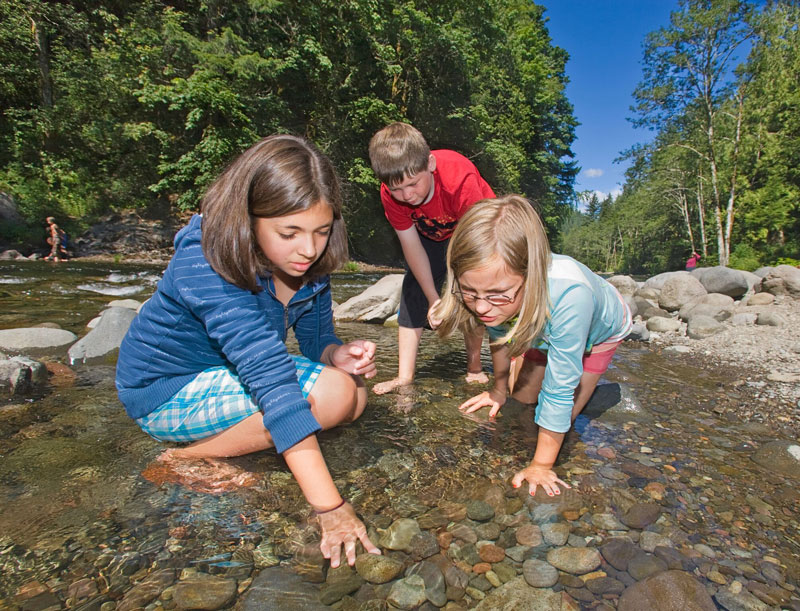
GROUNDBREAKING EVENT
On February 21, a groundbreaking event was held for construction of the new outfall.
Watch a video of the event.
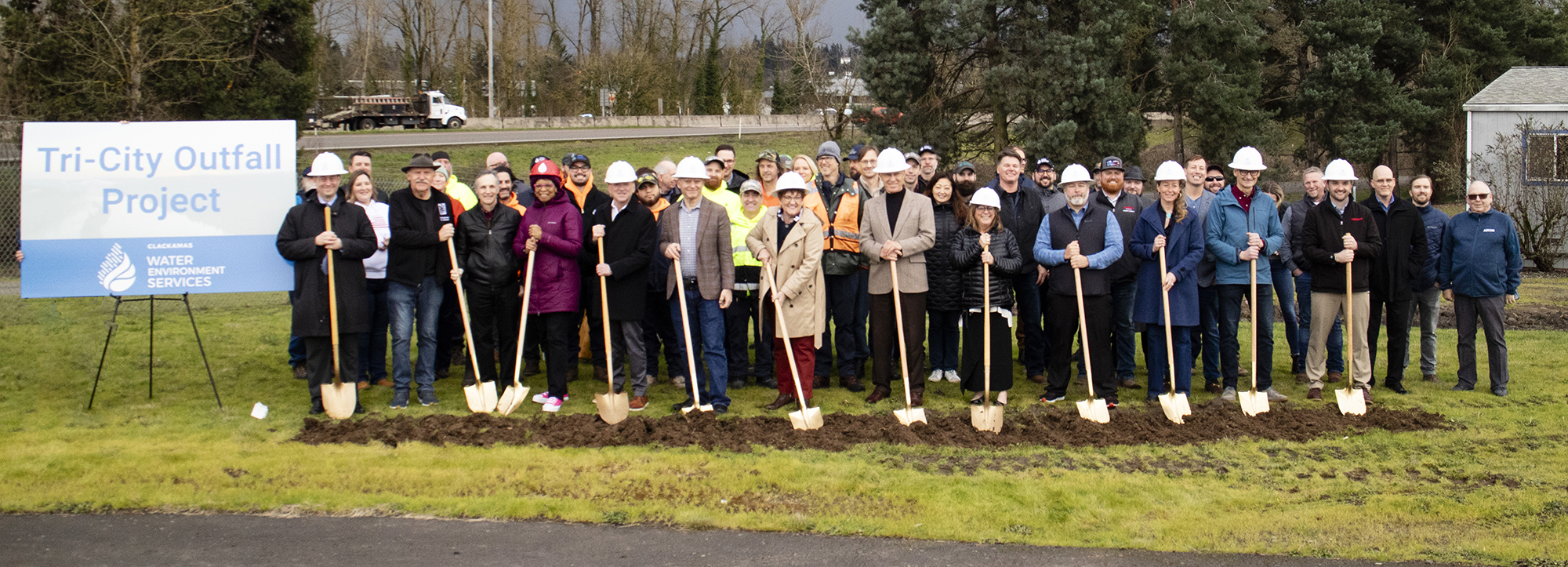
INFORMATIONAL VIDEO
PROJECT VIRTUAL MEETING
Learn about the project and how it will be constructed. Construction begins Spring 2024.
On January 23, 2024, the project team held a meeting to update community on the project and answer questions.
FACT SHEET
Read the Tri-City Water Resource Recovery Facility Outfall Project fact sheet.
Clackamas Water Environment Services produces clean water and protects water quality. It’s our job to ensure that residents and visitors enjoy the benefits of safe, healthy water for generations to come.
We operate and maintain five resource recovery facilities, 23 pumping stations and more than 360 miles of pipes.
Each year, we clean more than seven billion gallons of water. In the process, we convert materials that have long been considered “waste” into natural energy and fertilizer. We also help reduce pollution in local rivers, streams, and wetlands caused by stormwater runoff, the number one source of water pollution in Oregon.
We educate and assist community members from all walks of life. It’s our job to ensure that our families and neighbors enjoy the benefits of safe, healthy water for generations to come.
Our service area includes Boring, Fischer’s Forest Park, Gladstone, Happy Valley, Hoodland, Johnson City, Milwaukie, Oregon City, Rivergrove, West Linn and unincorporated Clackamas County.
WES is a Clackamas County department, a service district and a ratepayer-funded organization.
Background
The current outfall from the Tri-City facility was constructed in 1984 and is nearing capacity during peak wet weather events. In May 2019, the Clackamas County Board of County Commissioners approved an additional Outfall Project, which would be large enough to provide service for decades to come.
The existing outfall is structurally sound and will remain in place for use if needed. The new outfall will use gravity to convey the water from the treatment facility, so it will not require energy to pump water.
Location
The new outfall will run from the Tri-City facility parallel to I-205 and under the OR 99E off ramp. It will continue under Jon Storm Park and discharge into the Willamette River just north of the I-205 Abernethy Bridge. The Oregon City Charter calls for a vote of the people regarding the easements and for the construction of permanent structures unrelated to park use. In November of 2020, Oregon City voters authorized WES to place the wastewater pipeline underground in Jon Storm Park.
Project Planning
The outfall pipeline will tunnel beneath Jon Storm Park. Construction crews will adhere to the Oregon Department of Fish and Wildlife’s Willamette River in-water work window. The in-water work guidelines were created to minimize potential impacts to fish, Pacific lamprey, wildlife and habitat resources. In addition, WES’ consultants are performing an archaeological investigation and working in compliance with the National Historic Preservation Act. WES is also working with the Confederated Tribes of Grand Ronde Tribal Historic Preservation Office.
Construction will use a design-build process, where the design engineers and builders work together under a single contract from the beginning of the project. This method ensures the project stays on schedule and on budget.
Resources
Archaeological Information
Clackamas Water Environment Services consultants are performing an archeological investigation and working in compliance with the National Historic Preservation Act (NHPA). WES is also working with the Confederated Tribes of Grand Ronde Tribal Historic Preservation Office. The project will be done with a federal nexus through the U.S. Army Corps of Engineers, and compliance with the NHPA.
The slide below outlines the general strategy WES will follow to ensure that, through consultation and iterative project design, potential impacts to significant cultural resources will be accounted for and addressed prior to construction.
WES Archaeology Project Steps slide
Routing Study
- Outfall Alternatives Routing Study - Executive Summary (PDF, 808 KB)
- Segment 1 Routing Alternatives Evaluation (PDF, 4.2 MB)
- Segments 2A and 2B Routing Alternatives Evaluation (PDF, 23 MB)
- Willamette River Outfall Diffuser Siting Alternatives Evaluation (PDF, 874 KB)
Related Websites
Archived Materials
Ballot Measure
Resolution, June 17, 2020 (PDF, 119.1 KB)
Ballot Measure Language, June 17, 2020 (PDF, 342.2 KB)
Measure Explanatory Statement for County Voters' Pamphlet, August 6, 2020 (PDF, 2 MB)
News and Media
- Proposed Ballot Measure Fact Sheet August 2020 (PDF, 562 KB)
- Proposed Ballot Measure - Tri City Water Resource Recovery Outfall Project press release, August 5, 2020
- Proposed Ballot Measure Questions Answered August 2020 (PDF, 495 KB)
Meeting Materials
- City of Oregon City, City Commission June 17, 2020 - Meeting Agenda and supporting documents, June 17, 2020
- Project presentation to City of Oregon City, City Commission, June 17, 2020 (PDF, 9.2 MB)
Virtual Open House
WES hosted two virtual open house presentations, on August 26, 2020 and September 21, 2020.
View a recording of the virtual open house presentation below.
- What is an outfall? An outfall is the discharge point of effluent, which is treated wastewater. The outfall is designed to maximize mixing and dilution of effluent. The “mixing zone” must meet state water quality standards to ensure clean water for boating, swimming, fishing and aquatic resources.
- How will this project be funded? Will it have an economic impact? The project, which has a construction cost of $58,444,000 will be funded as part of WES’ Capital Improvement Plan. This includes all project management and administration costs, engineering design and construction services, and construction.
- Why is a replacement outfall needed? What happens to the current one? Built in 1984, the current outfall is nearing capacity during peak wet weather events. The replacement outfall will be large enough to provide service for decades to come. The existing outfall is structurally sound and will remain in place for use if needed.
- Where will the outfall be located? The outfall will run from the Tri-City Water Resource Recovery facility parallel to I-205 and under the OR 99E off-ramp. It will continue under Jon Storm Park and discharge into the Willamette River just north of the I-205 Abernethy Bridge. The distance from the Tri-City facility to the river is approximately 5000 feet.
- What are the environmental impacts of this project? The outfall diffuser will contribute to fish recovery in the Willamette River. Its location will be about 1,600 feet upstream of the existing outfall in a deep, stable aquatic bed feature that will better mix and dilute treated wastewater as it enters the Willamette River. It will maintain the existing cold-water fish refuge area at the mouth of the Clackamas River, and minimize future maintenance needs. This will also ensure the water meets state water quality standards, including water chemistry characteristics that fish need.
- What will the construction impacts be? For how long? Will it be loud? Construction impacts will last only a few months. Once complete, the outfall will operate without any obstructions to current river uses. Trenchless technologies will be used to minimize impacts to nearby properties and parks. Noise from construction activities related to the outfall will not be excessive.
- How long will the project take to complete? Construction is anticipated in 2024 - 2025 with operation starting in 2025.
- What will the outfall look like? The outfall will be completely buried and not visible. The outfall will be beneath the river and only smaller pipes will penetrate the river’s bottom. They will be in a deep segment of the river and will not interfere with boating, recreation or aquatic life.
- How far will the diffuser go into the river? The diffuser section of the pipeline will be buried under the riverbed, extend beyond the middle of the river and will be located at a particularly deep spot for better mixing that will enhance water quality. The actual diffuser ports will extend up above the diffuser bed. The diffuser is an improved river discharge mechanism that will be built at the end of the outfall.
- How will the river bottom and other aquatic life be protected during construction? Construction crews will strictly adhere to the Oregon Department of Fish and Wildlife’s Willamette River in-water work window. The in-water work guidelines were created to minimize potential impacts to fish, Pacific lamprey, wildlife and habitat resources.
- What is the temperature of the outfall? Will it warm the water? The model-predicted dilutions for the preferred 150-foot long outfall diffuser have been developed using current and future wastewater flows and maximum summer temperatures. The modeled results demonstrate this outfall will be well below the Oregon water quality temperature standards. The design of the diffuser will ensure that the outfall discharge stays well below any temperatures that could affect biological resources.
- What is WES doing to ensure archeological artifacts are not disturbed? WES is actively designing the project to avoid known archaeological resources in the vicinity of the project and will complete a due diligence effort to identify any previously unidentified cultural resources that may be affected by the project. WES will follow the Oregon State Historic Preservation Office project review process and regulations, and continue to work with the Grand Ronde Tribal Historic Preservation Office.
- Will this project impact the fishery? There will be no impacts on the fishery after construction is completed and the outfall is brought online. The outfall location will provide better mixing, which will help improve overall water quality in the river.
- What conservation measures will be taken? WES will deploy conservation measures to ensure that seals and sea lions, which may be present if fish are abundant, are not impacted by construction. The improved diffuser will ensure that treated wastewater doesn’t disrupt the natural environment and keep the river clean for swimming, boating, fishing, and aquatic life.
- What time of year will construction happen? Construction of the outfall pipe in the river will follow in-water work windows established by the Oregon Department of Fish and Wildlife (July 1- October 31 and December 1 – January 31). Construction of the land portions of the outfall could occur at any time during the year. Construction is anticipated in 2024 and 2025, with operation starting in 2025.
- What other improvements will be made? In addition to returning park property to its original condition, the project will also include enhancements to the park and surrounding areas, which may include native landscaping, riverbank restoration, trails and other needs identified by the City of Oregon City Parks and Recreation Advisory Committee.
- Will Jon Storm Park be closed? If yes, for how long? At this time, it is unknown if the park will need to be closed for any portion of this project. If the park does close, the closure time will be limited in duration and only impact the area of the park adjacent to construction.
- Will the Jon Storm dock be closed? If yes, for how long? It is anticipated that the Jon Storm Park dock will need to be closed for the in-water portion of construction of the outfall. Every effort will be made to keep the closure time to a minimum. WES will work closely with the City of Oregon City as potential impacts become clear.
- Will construction impact Abernethy Creek? Will the project include drilling through bedrock? Construction should not impact Abernethy Creek. The tunnel will not be going through bedrock, as bedrock is deeper than our anticipated tunnel corridor. The location of the new outfall diffuser in the Willamette River and the most inshore diffuser port location is approximately 400 feet distance from the mouth of Abernethy Creek. This substantial offshore location will allow a wide inshore region for fish migrating into Abernethy Creek. The project will specifically design the river diffuser ports and velocities to remain below the National Marine Fisheries Service’s “guidance” of less than 8 fps for outfall ports to avoid fish attraction.
- Will there be any risk of sewer overflow? Providing additional outfall capacity and reducing the amount of Infiltration & Inflow of extra water in the collection system will reduce the risk of potential sewer overflows.
- Will tunneling impact the groundwater or weaken the road? Could it create a sinkhole? Tunneling will not have an impact on the groundwater. Tunneling will not weaken the road or create a sinkhole. The outfall tunnel will be installed much deeper than the road subgrade.
- Will construction affect access to the Best Western Plus Rivershore Hotel? Will there be disturbances to the hotel or local roads? Access to the hotel will not be affected by construction. Additional information is being gathered and assessed to confirm tunneling options, which is WES’ preferred installation method. Tunneling would minimize impacts to local roads.
What is the construction process? Construction will use a design-build process, where the design engineers and builders work together under a single contract from the beginning of the project. This method ensures the project stays on schedule and on budget.
Please reach out to us with any questions, or to schedule a briefing to your organization.
Contact
For more information, contact:
Clackamas Water Environment Services | Customer Service
Phone: 503-742-4567
Email: WEScustomerservice@clackamas.us
To help ensure equal access to the county’s compliance plans, services, and activities, Clackamas County reasonably provides: translation and interpretation services, accommodations, and auxiliary aids. For these services, complaints, and additional information, contact 503-655-8291, use Oregon Relay Service: 711, or TTY/TDD 503-655-8757.
